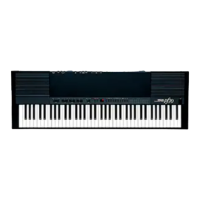
Do you have a question about the Yamaha PF-70 and is the answer not in the manual?
| Brand | Yamaha |
|---|---|
| Model | PF-70 |
| Category | Synthesizer |
| Language | English |
Choose installation location carefully, avoiding direct sunlight, heat, vibration, dust, cold, or moisture.
Clean exterior with a soft, dry cloth; avoid chemical solvents to prevent finish damage.
Do not open casing or attempt repairs; refer servicing to qualified agents to avoid shock or warranty void.
Unplug AC mains cord and all connecting cables before moving the instrument.
Avoid excessive force, dropping, or rough handling; treat the instrument with care.
In storms, turn off and unplug the instrument to protect against voltage spikes and surges.
Keep instrument away from sources of electromagnetic fields like TVs and radios to prevent malfunctions.
Push to turn the PF80/70 ON; push again to turn OFF. LED display shows status.
Adjusts internal speaker, output, and headphone volume; move left to reduce, right to increase.
Tailors sound frequency characteristics with LOW, MIDDLE, and HIGH controls.
Selects VOICE, FUNCTION 1, or FUNCTION 2 modes for voice selection or accessing programmable functions.
Turns the stereo tremolo effect ON/OFF for the selected voice, memorizable per voice.
Turns the stereo chorus effect ON/OFF for the selected voice, memorizable per voice.
Shows selected voice number in VOICE mode or function/value in FUNCTION modes.
Selects preset voices (1-10) in VOICE mode or functions (1-8) in FUNCTION modes.
Features 18W+18W stereo amplifier and 12cm full-range speakers for clear sound.
Offers acoustic piano feel with 88 keys (PF80) or 76 keys (PF70) and 16-note polyphony.
Turns internal speaker system ON or OFF, useful for external amplification.
Accepts standard stereo headphones; automatically turns off internal speakers.
Sends stereo signal at line level (left on II, right on I) for external systems or recording.
Accepts external line level signal to be mixed with PF80/70 sound through internal amp/speakers.
Connects optional foot controller to turn SOFT effect ON/OFF, affecting tone or string sound.
Connects optional foot controller for sustain effect, allowing notes to sustain after release.
Connects optional foot controller for piano-like sustain effect, supporting half-pedal sustain.
5-pin DIN terminals for MIDI communication with other equipment.
Sockets for plugging in the supplied music stand.
Explains how to select functions (e.g., F1-5) using the MODE selector and numbered buttons.
Describes how the LED display shows function names and programmed values in F1/F2 modes.
Adjusts the PF80/70's pitch relative to standard pitch (A=440Hz) using -1/+1 buttons.
Transposes the keyboard pitch up or down in semitone steps, covering a range of 2 octaves.
Adjusts the depth of the soft pedal effect applied when a foot controller is pressed.
Enables or disables touch response, affecting volume and timbre based on key striking force.
Reduces the volume of individual voices over a broad range to balance volume between voices.
Sets the speed of the tremolo effect for each voice, ranging from 0.1 Hz to 15 Hz.
Sets the depth of the tremolo effect for each voice, ranging from 0 (minimum) to 31 (maximum).
Limits note output to a range of keys, used with MIDI SPLIT for split keyboard functionality.
Shows how to connect the PF80/70 to MIDI keyboards for control and sound monitoring.
Demonstrates recording and playback of performance data using a MIDI sequencer.
Explains how to control external tone generators from the PF80/70 for richer sounds.
Illustrates creating MIDI systems with sequencers, tone generators, and drum machines.
Mixes MIDI signals from MIDI IN with PF80/70 data for transmission via MIDI OUT.
Determines which of 16 MIDI channels the PF80/70 receives data on, includes OMNI mode.
Sets the MIDI channel for transmitting PF80/70 music data to other MIDI equipment.
Turns MIDI NOTE EVENT, Control Change, and System Exclusive data transmission ON or OFF.
Transmits MIDI program change numbers (0-99) to select external voices.
Sets program change numbers for external keyboards or tone generators.
Sets the range of the pitch bend effect, varying by one semitone.
Splits the keyboard to transmit lower/upper data on different MIDI channels.
Drives external MIDI tone generators from different keyboard sections for versatile sound.
Lists MIDI parameters transmitted, including Note On/Off, Sustain, and Program Change.
Details channel information, voice messages, and control change data transmitted.
Explains channel voice messages, including Key On/Off, Control Change, and Program Change.
Covers System Real-Time and System Exclusive messages, including tuning and parameter changes.
Describes Active Sensing messages and System Exclusive parameter changes.
Lists System Exclusive messages for tuning, pitch bend range, and other parameters.
Details how MIDI data is received based on channel selection and MIDI MERGE settings.
Covers channel voice messages received, such as Key On/Off, Control Change, and Program Change.
Details received Key On/Off, Control Change, and Program Change messages.
Explains channel mode messages, specifically OMNI OFF operation for After Touch and Pitch Bend.
Details System Real-Time and System Exclusive messages received.
Describes Active Sensing messages and System Exclusive parameter changes.
Lists System Exclusive messages for tuning, pitch bend range, and other parameters.
Covers System Common messages like Song Position Pointer and Tune Request.